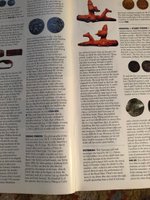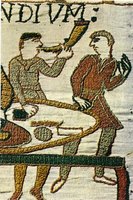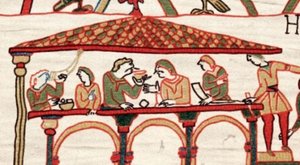Goad element of a parade prick spur ? found in England from the Viking Age of possible Slavic origin.
'It is hard to make allowances for the oddities of human figures, it is harder still to make rational judgments about the carvings of unidentifiable animals, yet without making the effort we will be continually troubled with the inconsistencies in what we make out of what we think to see'.
'.. but it is quite another matter to assume that the interpretation put upon them in their original culture would also have been carried over'
With these quotes from Rita Wood book Paradise, the world of romanesque sculpture, I like to start off the first object of this collection of artefacts from the era of the Viking Age. Rita Wood's statements are wise ones. Of course they aren't limited to sculpture of the romanesque period, but are - very much so - needed in the back of the mind when it comes in the ever-going-on interpretation of Viking Age objects.
First of all: excuse for the more than ugly title of this page, addressing this item. It has a reason why, of course, wich I will explain on this page. This is going to be a 'living document' on this object/type of objects, as in- and hindsights are ever developing, as it will show us.
In the beginning..
There was - and still is an utmost intriguing object from copper-alloy, about 60 mm long, 40 mm high and 20 mm wide.. rare, as it is from three-dimensional nature. Depicting a helmeted man with a horn on a horse-like animal, riding it.
Having been found in 2005 or 2006 in England in the East Midlands, Leicestershire in Charnwood - the PAS record https://finds.org.uk/database/artefacts/record/id/125045 (link) isn't conclusive on this, it immediately was a remarkable, important find, wich nevertheless was 'returned to the finder' - to my luck, because of why it got on the market. The record addressed being it the goad of a prick spur, stylistically to the Viking Age and perhaps the 11th century.
Two key arguments I think then excist for addressing this object so. From the 11th century (or: approximately) several 'horse related adornments' - like fittings/strap junctions/deviders, stirrup mounts and terminals and harness pendants have been found the last 20, 25 years often in very elobarate decoration/forms. This kind of horse harness decoration, at least found in England, belongs to the late(r) Viking Age.
Then: a man on a horse with a drinking horn. How much Viking would one have it? Or, is it?
The Searcher's Magazine published the object in 2006 (see image) - and was aroused as could be. Addressing it to a drinking horn. Of course, the object would make quite an impression on a drinking horn. Everybody would drink out of your personalized horn, being a Norse man or viking at the time itself and seemingly being of common practise then. But, is it?
The key question is what kind of imagenery we are looking at ?.
The PAS record for example is addressing the animal as 'horse or dog?'. Now, it may seemingly feel strange to ride a dog with a horn in your hand, it might have had deliberately so be depicted. The dog having a common known meaning in the imagery related to the rider with its horn. We have to keep all things in mind, as stated very often here, the smith did not left his portfolio for us.
In the PAS record addings since 2005/2006 have been made to recent finds in Seehausen and Mecklenburg Vorpommern. The Seehausen example does resembles the example, found in England. Yes, there is the 'rider' again, holding a horn with somewhat curled, outstreched arms in front of him. The animal not further to be recognized as the front is missing on this piece. Some distinct differencies in my opinion also. I agree on the similar form, but not its distinct decoration. The example found in England I think is of a more crudely casted decoration, hence the same three dimensional casting witnesses for the great skill of its caster. The more crudely casted imagery wich can be recognised on Anglo-Scandinavian items also.
So, a main research question here is: What seemingly, commonly known - over a larger region - imagery had been used and can it be addressed to imagery known from p.e. mythology?
In the PAS record, a link to 10th- to 12th century Slavic four-faced god figurines holding drinking horns has been pointed out (e.g. one from Zbrucz, Ukraine - see link in the PAS record).
Now, first, four-faced god figurines is something different than the one-face figurine we are discussing here.
Another research question wich pops up in my mind is: Isn't the exact meaning of an object not exclusive that one, with wich purpose it was casted in the area it was 1) or found or 2) casted or 3) bought from a trader from p.e. another area?
In other words: having been found in England, is it possible that, to the owner, this depiction might have had it roots in Norse mythology? A man on horse, - if we think of this object as part of a parade - Prunkspor, as it is described in German, relating to the similarlike element of the example found at Seehausen - prick spur - the long goad - who had adorned it with such imagenery because it had a special meaning to him?. Of course it must have had, surpassing just having it been an element of practical use.
One could addresses such thoughts both from the perspective of the smith who made the item, as from the receiver/wearer/user of the artefact. Maybe this sounds revolutionary, but I am just throwing a bal up here. Maybe a research question within itself!
Leszek Gardela pointed out to me - in his article The buried warriors of Poland, Lutomiersk unveiled - that parade prick spurs were found in an Slavic late 10th - 11th settlement accompanied with parade/decorative goad elements. These type of goad elements from the Viking Age thus are known from East Europe.
And: of course: leaving aside the question: was the object ever used with the purpose of being part of a prick-spur, as the PAS record states: 'the object has no obvious breaks or signs of fixing it to anything'..
Had the object ever been used, or used just for being 'beautiful', and so never connected to a horses equipment? See for example a sword strap devider where one find of, was used/re-used as a trefoil brooch.
Now, having showed the artefact to James Graham-Campbell, he responded:
I'm afraid that I have to disagree with the PAS record where it states that 'stylistically it belongs to the Viking Age' - and likewise Scott's claim that its 'decorative scheme is clearly Scandinavian'. Why should this be from 11thC rather than the 12th?
and:
For me, the animal-head displays no convincing Scandinavian characteristics - and conical helmets are standard for the 12thC!
Then: If so, and being from the 12th century, could the Charnwood example be of Anglo-Norman origin/use, using a known depiction/decoration from another area. And, if, possibly being of Anglo-Norman origin, imaging the of course, well known imagery of cavalry men, feasting before or afterwards with drinking from a drinking horn, as an image on the Bayeux tapestry clearly shows us.
Concluding..
All in all, the primary conclusion appears to be that this element is - used or not - the parade goad of a prick spur, having its only similar counterpart in the example found in Seehausen, although the exact execution when it comes to details, is different (head) and the animal cannot be compared - as it is lacking - on the Seehausen example.
The distinction 'parade' is addressed to me on basis of the information discussed on the Seehausen example and the Lutomiersk finds and on basis of the logical fact that such an adorned goad of a prick spur wouldn't have functioned 'in action' as the point of the goad in my opinion wouldn't have been long/protected enough from the rest of the element to have functioned this way. Set aside that the Charnwood example have no traces of having been attached to the spur (or: whatsoever).
A connection to the Slavic deity Svantevit is debatable, as this god always is depicted with a four sided face. Chronologically it is from the Viking Age, but an exact date/century is still to be addressed.
Maybe future finds will shine more light on this mystery object..
Firmly - 'to be continued'..
Well. I could have been with these stones until after dark, but as my wife wanted to travel on.. well.. I see you again, some day, hogback stones from Gosforth. And if you happen to be there one day, do not forget that monument on the outside...
Further on with the Cumbrian hogbacktour !
In - yes, luckily again in - St. Peter's church in Heysham, there is a truly beautiful hogback stone. The guide told us, it had been studyied by Thor Ewing, a writer, in 2000. in 'Understanding the Heysham hogback' A tenth century sculpted stone monument and its context (link), Thor Ewing tells in detail what he dicovered on the both sides of this hogback stone.
Just being brought in the church as late as the 1970's accompanied with some protest here and there among the church visitors, considered as being a token of old paganism, it had been remarkably nice preserved, and a lot of detail can be seen, still. Truly worthwile a visit.
I had a small debate with the guide in the church if the - zoomorphic, in my opinion - faces on the sides were lions (or hippo's). The guide doubted if the vikings could have known about lions. Well I guess so, concerning the runes on the Ancient Greek lion statue at the Arsenal, Venice. For example. Vikings did travel south..
But when he told me he was doubting the vikings 'discovered' (as the native inhabitants were of course, in the first place) America before Columbus, I decided to rest my case..
One has to know when to start and to end a conversation ..
Just discovered the book in a bookstore written by Geoff Holder - The guide to the mysterious Lake District, I knew there had to be another hogback stone in Lowther, St. Micheal's Church. With a promising image described in the text of 'a naval and a land-based force of shield-bearing vikings above a fish and what might be a coiled sea serpent. On the reverse is a row of female figures with snakes, possibly a representation of the hideous hag Hel'. Wow. If that did not sound as a true pagan promised land ..
Not complaing too much after all we have seen, this visit was the dissapointing one of them all. But if you wife states 'I am happy to have seen them' and I am answering 'Measuring is knowing' and the even more obligate verb 'handling 'if we did not see it at all, we wouldn't have known anything at all of how they were looking' the glass was again half full, at the last day of our journey..
The hogback stone appeared to be just being tolerated within the entrance segment part of the church. As something you never use anymore but you do not throw away - entirely. That sort of feeling emerged when seeing this hogback asylum seekers.. Bed, bath and bread, ás we say in Dutch, but no luxury at all and standing on some outcuts of wood, you would balance the table with at home..
Come on, St. Micheal's Church.. care a bit more of your 'children' !
This hogback stone was moved in the church in 1907. Hogback stones layed partially buried in the churchyard before it was dug up and moved into the church.
The promising depiction of a longship - as certainly can be seen after some studying - see http://vikingminds.co.uk/pages/longship
we have missed !
The stone itself is (157 x 50 x 30 cm) and very worn.
The hogback stones in Cumbria - very diverse in quality, but everyone worth a visit ! Especially on a gloomy day in late October ...
The churches to visit - see photos of resp. St. Andrew's church in Penrith, St. Mary's church in Gosforth, St. Peter's church in Heysham and St. Micheal's church in Lowther.
Did I miss out on another one in Cumbria ? Let me know !
In a next blog I will take you to four - still remaining utterly mysterious- statues 'guarding' the graveyard of St. Andrew's church in Dacre..
For the last blog of October 9th see this link.
References: (as always, links to where the books can be ordered are attached).
Edwards, B.J.N. Vikings in North West England - The artifacts (1998);
Emery, Gordon, CURIOUS CUMBRIA, The Lake District & Beyond: A celebration of Cumbria (2023)
Ewing, T. 'Understanding the Heysham hogback' A tenth century sculpted stone monument and its context ;
Hall, R. Viking Age archaeology in Britain and Ireland (first printed 1990, reprinted with amendments in 1995);
Holder, G. The guide to the mysterious Lake District (2009)
possibly also (as there within the part of Cumbria dealing with Carlisle, the Eden Valley, Barrow-in-Furness, Whitehaven and the west coast is being dealed with)
Holder, G. Paranormal Cumbria (2010)
http://vikingminds.co.uk/pages/longship












